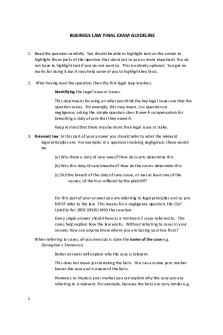Law Final Exam 2021 PDF
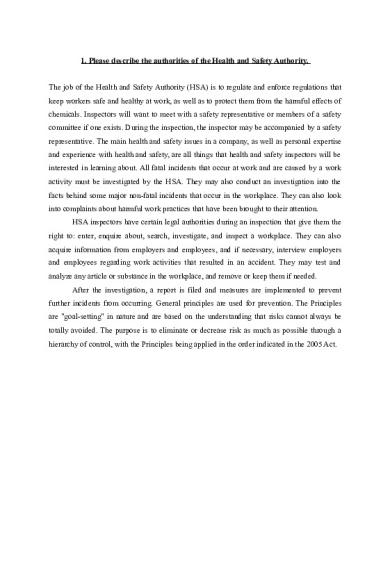
| Title | Law Final Exam 2021 |
|---|---|
| Course | Environmental Law |
| Institution | National University of Ireland Galway |
| Pages | 4 |
| File Size | 139.8 KB |
| File Type | |
| Total Downloads | 27 |
| Total Views | 178 |
Summary
law essay with multiple answers...
Description
1. Please describe the authorities of the Health and Safety Authority. The job of the Health and Safety Authority (HSA) is to regulate and enforce regulations that keep workers safe and healthy at work, as well as to protect them from the harmful effects of chemicals. Inspectors will want to meet with a safety representative or members of a safety committee if one exists. During the inspection, the inspector may be accompanied by a safety representative. The main health and safety issues in a company, as well as personal expertise and experience with health and safety, are all things that health and safety inspectors will be interested in learning about. All fatal incidents that occur at work and are caused by a work activity must be investigated by the HSA. They may also conduct an investigation into the facts behind some major non-fatal incidents that occur in the workplace. They can also look into complaints about harmful work practices that have been brought to their attention. HSA inspectors have certain legal authorities during an inspection that give them the right to: enter, enquire about, search, investigate, and inspect a workplace. They can also acquire information from employers and employees, and if necessary, interview employers and employees regarding work activities that resulted in an accident. They may test and analyze any article or substance in the workplace, and remove or keep them if needed. After the investigation, a report is filed and measures are implemented to prevent further incidents from occurring. General principles are used for prevention. The Principles are "goal-setting" in nature and are based on the understanding that risks cannot always be totally avoided. The purpose is to eliminate or decrease risk as much as possible through a hierarchy of control, with the Principles being applied in the order indicated in the 2005 Act.
4. Discuss the basic elements of Negligence in relation to Employer’s Liability
Employees can bring public liability claims against an employer, and this liability can surface through a variety of circumstances, including; employers can be held directly liable for negligence regarding their workers’ under common law; under the doctrine of vicarious responsibility, an employer can be held accountable for the activities of his employees to third parties; and finally under The Health and Safety at Work Act of 2005 imposing statutory liability.
Employers’ Standard of Care The courts should bridge the gap between improving an employee's legal position and imposing an undue duty on employers to exercise reasonable care, so the employer would not be an insurer. In the case of Bradley v CIE, it was established that if an employer performs what a sensible and reasonable person would have done in the circumstances, they have fulfilled their duty of care. To be successful in a case, an employee must prove the following elements of negligence were followed: causation, injury, fault, reasonable foreseeability and proximity.
Harassment and Bullying in the Workplace If an employer has permitted bullying or harassment in the workplace to develop, they may be accountable for a psychiatric disease caused by the behavior. The plaintiff complained about bullying to his employer several times in Quigley v Complex Tooling, however, no preventative actions were taken. The plaintiff was fired soon afterwards, and he experienced severe depression as a result. The High Court upheld his allegation and enforced liability, proposing the following description of bullying in the workplace: ‘Repetitive inappropriate behaviour, verbal or physical, directly or indirectly, actions by one or more individuals toward another in the place of employment, which may justifiably be considered as attempting to undermine the person's right to dignity at work." It cannot be deemed harassment if it were a unique or individual occurrence.
Stress-Related Injuries Stress induced by an employer's failure to enforce an adequately safe working environment is
becoming more common in case law. The majority of the cases included employees who had a mental breakdown as a result of their overwork. In such a case; an employer has a responsibility to regulate the level of work demands caused by the network to eliminate stress-related ailments; track employees' resources to react with challenges made on them during the system; as well as ensuring that anything that can be effectively designed to stop an incapacity to deal with developing into an illness through the structure. The plaintiff complained to his employer in Maher v Jabil Global that his workload was causing him stress. He took a break from work and when he returned, he was demoted to a less demanding position, but he claimed he continued to experience stress as a result of being in a less demanding position. The court refused to declare the employer negligent since the plaintiff’s first workload was equivalent to those of other workers in the same capacity, making the injury unforeseeable, and his secondary part had less labor, making the injury unforeseeable again. In Maher, the court alluded to the Hatton liability test and reformulated it into a threequestion test for investigating liability; did the employee experience a health problem that wasn't related to his job?; was it a result of their career?; after analysing all conditions, was the incident reasonable foreseeability?.
5. What is the role of the Intergovernmental Panel for Climate Change? Which international organisation initiated its creation? The IPCC was established in 1988 by the World Meteorological Organization (WMO) and the United Nations Environment Program (UNEP) with the goal of providing scientific information to governments at all levels for the development of climate policies to deter its impacts and future risks, as well as adaptation and mitigation alternatives to policymakers. As per the ipcc.ch website, IPCC reports are a crucial element of global climate change talks. The IPCC conducts its assessments to identify the impact of scientific agreement in various areas and to focus on areas where more research is required. The Intergovernmental Panel on Climate Change does not conduct its own research. Hundreds of renowned scientists give their time and skills to write IPCC assessments as Coordinating Lead Authors and Lead Authors of the reports. They solicit the help of hundreds of additional professionals as Contributing Authors to enhance their knowledge in specific areas. Currently, the report authors are divided into three categories; Working Group I: the Physical Science Basis; Working Group II: Impacts, Adaptation and Vulnerability; and Working Group III: Mitigation of Climate Change – and the Task Force on National Greenhouse Gas Inventories (TFI). The Task Force on National Greenhouse Gas Inventories has as its primary goal the development and refinement of methods for calculating and reporting national greenhouse gas emissions and removals. Other Task Groups may be formed by the Panel for a specific topic or question, in addition to the Working Groups and Task Force....
Similar Free PDFs

Law Final Exam 2021
- 4 Pages
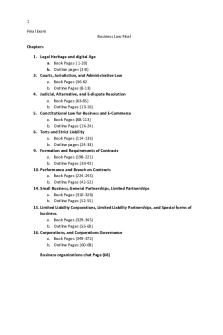
Business LAW Final EXAM
- 70 Pages

Taxation LAW Final EXAM
- 8 Pages

LAWS2205 2021 Final Exam Paper
- 5 Pages
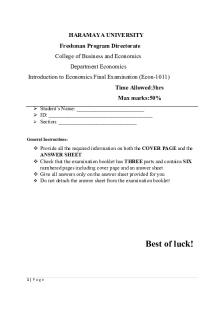
FS final exam 2021 Edited
- 6 Pages

Final Exam Review - 2021 261
- 3 Pages

Radiology Final Exam Guide 2021
- 2 Pages

FALL 2021 Final EXAM Schedule
- 1 Pages
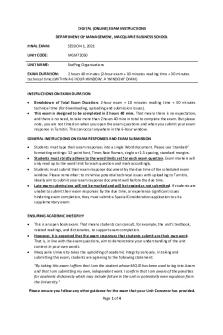
MGMT2050 - S1 2021 - Final Exam
- 4 Pages

Law exam 1 - law exam
- 31 Pages
Popular Institutions
- Tinajero National High School - Annex
- Politeknik Caltex Riau
- Yokohama City University
- SGT University
- University of Al-Qadisiyah
- Divine Word College of Vigan
- Techniek College Rotterdam
- Universidade de Santiago
- Universiti Teknologi MARA Cawangan Johor Kampus Pasir Gudang
- Poltekkes Kemenkes Yogyakarta
- Baguio City National High School
- Colegio san marcos
- preparatoria uno
- Centro de Bachillerato Tecnológico Industrial y de Servicios No. 107
- Dalian Maritime University
- Quang Trung Secondary School
- Colegio Tecnológico en Informática
- Corporación Regional de Educación Superior
- Grupo CEDVA
- Dar Al Uloom University
- Centro de Estudios Preuniversitarios de la Universidad Nacional de Ingeniería
- 上智大学
- Aakash International School, Nuna Majara
- San Felipe Neri Catholic School
- Kang Chiao International School - New Taipei City
- Misamis Occidental National High School
- Institución Educativa Escuela Normal Juan Ladrilleros
- Kolehiyo ng Pantukan
- Batanes State College
- Instituto Continental
- Sekolah Menengah Kejuruan Kesehatan Kaltara (Tarakan)
- Colegio de La Inmaculada Concepcion - Cebu
